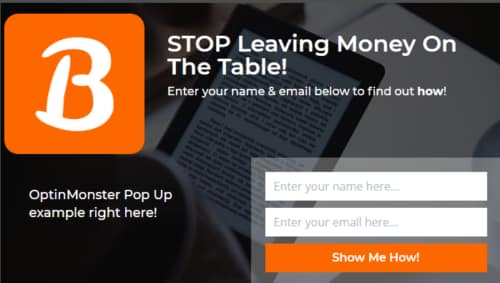Last Updated on April 28, 2020 by Nadim Alamuddin
If you Google “Stop leaving money on the table,” you’ll probably get results about “pricing with confidence.” True, but there’s something else in your online business that you can be doing that you should stop immediately: not capturing your prospects email addresses. This post is about how to capture your prospects’ email addresses, also known as “building your list.”
Building Your List is one of the most important objectives you must do on your blog. To be able to build your list, you must have ways on the blog to capture email addresses of your potential audience. Once you capture these email addresses, you should have a way to automatically send blog updates and promote your products and services.
Table of Contents
Why Capture Email Addresses?
Let’s explore why you want to capture email addresses. Suppose you have a promotion on your blog and you send people right to the sales page, without capturing their email address. You’d be leaving money on the table. If this prospect goes and buys the product, you may still get your commission, but you’ll have no way in following up with your customer. You may want to offer your customer further value, but now, you have no idea how to reach him/her.
Building your list is crucial to email marketing, as you’ll be constantly offering more value to your “list”, all the while building trust and consistency. This ensures your customers and readers come back to your blog, thereby increasing your loyal readers and your overall traffic.
How To Capture E-Mail Addresses
There are many tools that capture email addresses. Some of these tools may reside on your WordPress platform, in the form of a plugin, which is a small program that adds functionality to your WordPress. Other tools may be standalone and can integrate to your blog or other social media platforms.
These tools can be configured to capture all kinds of info, but the most popular is to capture first name and email address. And now that privacy is so important, most tools conform to your privacy, by providing a checkbox or a privacy policy to outline how information is captured and used.
What Are Opt-In Forms?
We’ve all seen some of these tools on most websites and social media platforms. These are usually called “opt-in forms” because you, as the prospect, opt-in or “choose to apply” to the form. In most cases, there will be something interesting displayed for you to opt-in. Examples are:
- Free E-book Download: Sure, it’s not exactly free, as you will need to provide your email address in exchange for the free e-book.
- Content Upgrade: This is when a blogger provides something extra on top of the blog post, but which complements the post. For example, a printable Cheat Sheet or checklist of the topic of the blog post, or an Infographic showing the process being discussed. Any of these can be used to get the reader to provide their information so as to gain access to the “promotion” being offered.
- Free Course or Tutorial: this follows the same lines as discussed above
Some Examples of Types of Opt-In Forms
Opt-in forms come in all shapes and sizes and include the following:
- Pop-up: these may pop-up as you try to exit the page, or after you’ve been on the page for a certain time, or even if you’ve scrolled a certain length down the page. I do have an exit pop-up opt-in form asking you to subscribe to my blog.
- Slide-in: these are usually small subtle opt-in forms that “slide-in” from the right, left or bottom of the page as you’re reading the blog post.
- Hello bar: this is usually a header in a different color that appears as you read a post, a more subtle approach to get you to opt-in for an offer or subscription.
- Embedded: this is usually inserted within the blog post, breaking up a section, or put at the bottom of the post. Sometimes, it may be on the left or right frame (called sidebar) of the blog post. For example, on my blog, I do have an opt-in form at the bottom and on the right for you to subscribe to my blog.
- Landing Page: this is usually a page that you are redirected to. The whole page would have some marketing promotion (called ad copy) and an opt-in form to capture your email address.
- Squeeze Page: Like a landing page, this is usually a URL (address on the web) that you’re redirected to, but is just like an opt-in form – it has very few words or promotion text (Ad copy) and a name & email input for you to fill in.
Opt-in forms are usually integrated with another tool that stores these contacts within it. This tool’s main function is to provide email marketing, which is an automated way to send emails and/or newsletters to your prospects or “list.” Be sure to read “Best 3 Benefits Of Email Marketing To Your Business,” for an in-depth look at email marketing and its associated tools.
Affiliate Disclosure
| This blog post contains links that take you to external sites, featuring products that I recommend, based on my experience with them. If you decide to purchase from them, I may earn a small commission, at no additional cost to you. For more info, check out the Affiliate Disclosure. |
My No. 1 Tool For Opt-In Forms – OptinMonster
As I started my blog, I tried several tools (free & paid) that provided opt-in forms as plugins or as separate applications that can integrate with your blog. It wasn’t until I tried OptinMonster that I was finally satisfied with what I was looking for.
OptinMonster offers a variety of functions that are also available in most other tools. However, because it is a paid tool, it affords to offer superior functionality that makes it quite unique.

OptinMonster: Opt-In Forms On Steroids!
Here are some of its powerful functionality:
Easy to use interface:
This is one criteria that I loved about this tool. User-friendliness. I have tried using other tools and found them not so user-friendly. OptinMonster is so easy to use and its menus are clear and unambiguous.
Templates:
OptinMonster is SO rich in templates! I never thought of myself as very creative. If I had to create an opt-in form from scratch, it’ll probably take me hours. OptinMonster makes your choice so much easier by providing templates for almost every scenario.
Opt-In Types (called Campaign Types):
These include pop-up, exit-intent (which are those pop-ups that appear as your cursor reaches the close button, as you’re trying to exit the page), slide-in, full page, floating bar (these are strips that appear at the top or bottom of your post), etc. You will have a list of pre-defined templates for each type, making it super easy to design your form.
Configurable Rules
OptinMonster lets you configure how your opt-in form should trigger and what criteria or rules it should abide by. This makes it extremely versatile at designing opt-in forms for every possible scenario you could think of. For example, if you have a returning visitor to your blog, the tool recognizes you and personalizes your user experience.
Yes / No options
These are more commonly known as A/B testing. This is the ability to setup two opt-in forms that are different from each other in only one aspect, say the background picture. This way, you can test which one captures more emails and fine-tune your findings.
Integration Options
OptinMonster provides many integration options to popular email marketing tools (known as Autoresponders). When people opt-in on your form, it needs to be integrated to your email marketing tool so that you can automatically send emails and/or newsletters to your “list.” Again, I found that OptinMonster has more integration support than most opt-in tools available.
Integrated Analytics
These enable you to monitor and measure the opt-in forms’ success, by seeing the number of visitors to your opt-in, how many clicked (leads), how many opted-in (conversions). You can even drill down to find out which blog post and form gave you the most conversions. By monitoring this progress, you can fine-tune your forms accordingly.
As I said earlier, there are many tools on the market that can do some of these functionalities. Here are other good tools to consider:
- LeadPages: This tool is mainly known for its superior landing pages design. It also provides opt-in forms and integrates well with all popular email marketing tools (autoresponders). I have a running subscription of LeadPages and have used it primarily to create landing pages for products I have promoted in the past. Great product, albeit a bit steep in price ($37/month).
- GetResponse: GR is mainly known as an email marketing tool, an autoresponder. The opt-in forms feature has over 500 built-in templates to choose from. This is a good all-in one package ($15/month for all features. You will have to upgrade as your list grows).
- Thrive Leads: This is a WordPress plugin that is one of the favorites for 2018. Before installing and activating OptinMonster, I had read great reviews about Thrive Leads and tried it. And…uninstalled it, when I found out the price tag! ($59/month)
- Sumo List Builder: This is a free plugin on WordPress for your first 200 subscribers. It offers a multitude of opt-in forms to start on. Its premium package starts at $24/month.
OK, So How Do You Move Forward?
I have just shown you how to capture your prospects’ email addresses. Now, you need to create a plan of action and implement it. Choose one tool you’re comfortable with, such as OptinMonster, install and activate it. Start with one or two opt-in forms, just to test the waters.
Some people like pop-ups or exit-intents, where others completely hate them. You need to experiment with different options until you see how the forms are doing. Then, you can fine-tune your strategy and add more forms.
Stop leaving money on the table by implementing these opt-in forms on your blog and/or your social media. It’s that important.
As you capture these email addresses, you will build your list in your integrated Email Marketing tool. You will use this tool to send emails and/or newsletters to your lists to keep them coming back to your blog and/or promote other products & services. As mentioned before, read my post on Email Marketing and how to grow your list.
Thank you for reading this post. As mentioned in the beginning, I have written this post for the beginner blogger or entrepreneur. If you are new to blogging, please read these three posts as well:
- From Zero To Blog In 5 Steps
- How To Create Your First Epic Blog Post Using Gutenberg
- From Zero To Niche In 30 Minutes
If you’ve liked this post, please leave me a comment below and share it on your social media networks. Ideally, it would be great if you can share your own experiences on how to capture email lists on your website.
To your success!
Are you on Pinterest? Then pin the image below!




Again, great post! Looking forward to your next post on email marketing.
Keep ’em coming!
Hi May,
Thanks for being a loyal reader and for your comments. Well, if you’re waiting for the Email marketing post, it’s going to be published in a couple of hours!!
All the best!